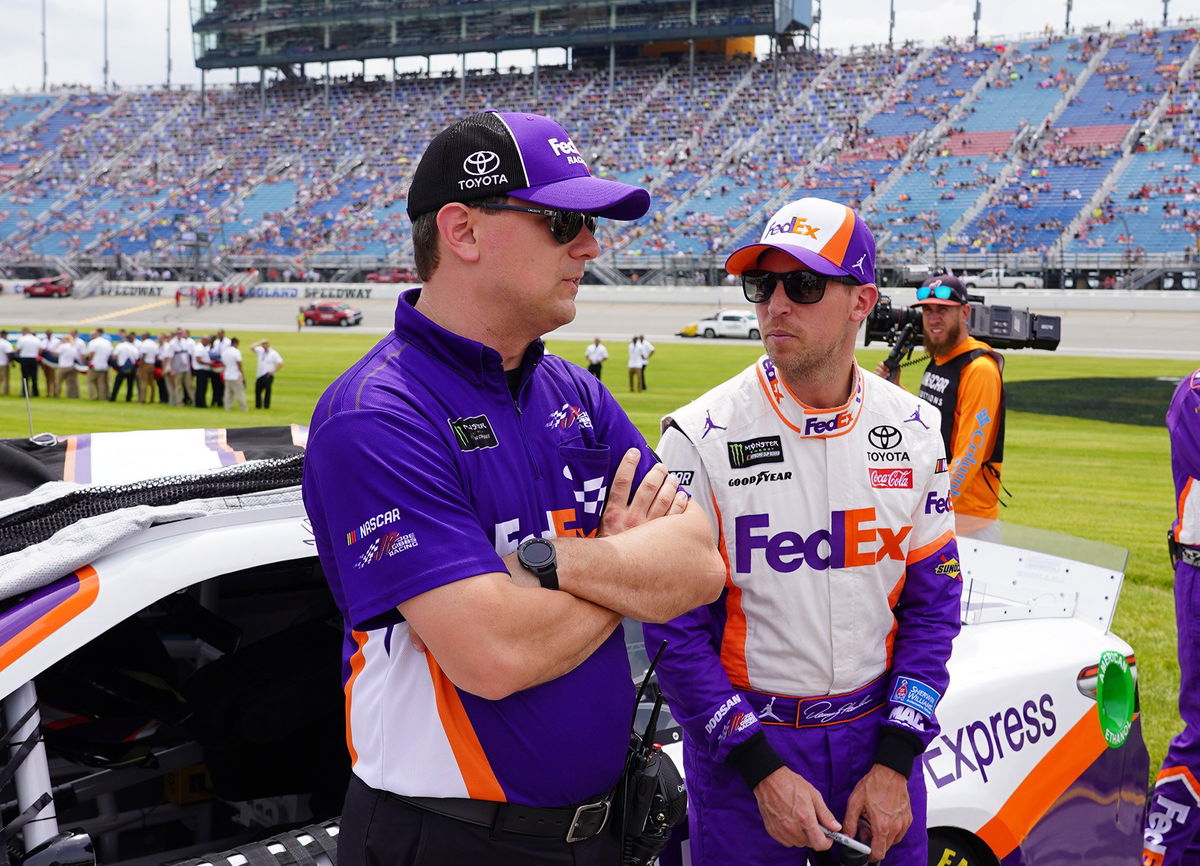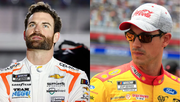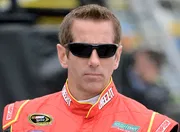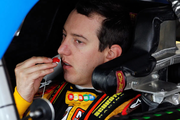

How close is too close in NASCAR? That’s a question very few can answer, otherwise, parity would only be a distant concept and not a raging debate surrounding the Next Gen car. In 2024, the field has been closer than ever. Yet only one-third of the chartered teams have been lucky enough to manage a race win halfway through the season.
Watch What’s Trending Now!
However, the considerable lap differential has been almost unnoticeable when analyzing the gap between the leaders and the rest of the field. So has NASCAR’s desire for an even more level playing come to fruition with all their changes to the Gen 7 car’s single-spec bodies? As we stand, the races have surely gotten closer than ever. But the biggest problem remains an inability to pass on the racetrack. In a conversation with Kevin Harvick, Denny Hamlin’s crew chief talked about an impressive solution to that notion. And it’s as simple as just bumping up the engines with about a couple hundred horsepower.
ADVERTISEMENT
Denny Hamlin’s crew chief calls for “wild” adjustments to “easy” Next Gen car
New Hampshire threw a couple of wrenches on NASCAR’s big parity problem. First, the rains wetting the race track following a two-hour-plus rain delay resulted in a highly unpredictable encounter with cautions and limited room for game-winning calls. Second, the race-winner, Christopher Bell, figuring out the groove to the T and holding the lead on those last 64 laps resulted in quite a dominant affair inside a confusing cycle. The major thing that irked many was that the teams could not change their wet weather tires back to slicks, courtesy of the sanctioning body. But in between 5 or so restarts, strangely no cars managed to exchange the lead with the eventual winner.
On the other hand, Bell’s JGR teammate, Denny Hamlin, couldn’t figure out the Goodyear wets and faced a considerable loss of track position, evidenced by a P24 finish compared to the #11’s front-running moments before the rain-induced red flag. Yet, when Denny crossed the start-finish line, he was all but 5.173 seconds behind the #20. Compare that to Ryan Newman’s P24 finish at the last New Hampshire race before the Next Gen car’s introduction (the 2021 Foxwoods Casino) and Newman was a whole lap behind the winner of that race, Aric Almirola.
Instances like these could be written off easily, but to explain their true implications, Chris Gabehart, crew chief of the #11 JGR Toyota, sat down with Kevin Harvick on the latest episode of his “Happy Hour” podcast. Gabehart duly emphasized, “When I look at the stated goal of parity, and that is every driver and every team can buy the same parts and have the same opportunity to go win a race. I think that’s a great stated goal. The problem is physics gets in the way.”
ADVERTISEMENT
Chris Gabehart tells @KevinHarvick that parity is a great goal but the “problem is physics gets in the way.” He has some suggestions for the Next Gen car. #NASCAR pic.twitter.com/5OROsRlir5
— HarvickHappyHour (@HarvickHappyPod) June 27, 2024
“And the car that’s leading is gonna have an advantage over the car that is in second, and it’s quantifiable… And, If you can’t overcome that disadvantage, then what you’re actually doing is you’re handcuffing all the drivers and all the teams into an execution battle. It simply becomes a race of QC, Monday through Sunday. So in my view what we’ve gotta do, as wild as this is to say in a world of ten thou…” – he began outlining a plausible solution in a time where cars are meticulously micro-managed down to the thinnest of wires.
ADVERTISEMENT
“But what we’ve gotta do is make it harder,” declared Gabehart with an aura of much deeper understanding. He elaborated on this ambiguous statement, saying, “I think whether it’s more horsepower or smaller footprints on the tires which I think we could do by the way. I mean, (with) all the revisions that we’ve made to this car, how big a deal would it be to make a two-inch narrow wheel from the inside to make the footprint tire smaller? We simply have a horsepower-to-grip ratio imbalance. We knocked out 100 horsepower, we went to a wider tire. Went to independent rear suspension. We increased grip, decreased horsepower. That’s too easy for you.”
Gabehart cited some of the most notable adjustments on the Next Gen cars that differentiate them from the Gen 6 models and produce theoretically tighter racing. The Independent Rear Suspension (IRS) is a change implemented with the visible future in mind, a longshot from the solid-rear axles of earlier cars. According to Gabehart, NASCAR adopting the wider 18″ tires compared to the previous generations’ 15″ also leads to further discrepancies, coupled with the few hundred Cubes chalked off the V8 engines by single-source suppliers under the governing body’s new rules package.
It is important to remember that more than half of the race winners from the last 18 points-paying races of the season started their glorious advances at positions inside the top 10. Hence, he also suggested that “the disadvantage from however you line up on the track from a given scenario is hard to overcome.”
ADVERTISEMENT
Denny Hamlin’s crew chief then concluded with an anecdote on how he conducts “a survey every week” based on “how you’re parking in the garage.” And Gabehart finished his thought with yet another pit box secret, “How you’re parking in the garage every week kind of gives you a litmus test for: how are we doing? I had two Hendrick cars to my left. One to my right. Two Toyotas to the right of that one. Pretty telling that the best teams are still finding their way to the front. But the optics are: it’s harder than ever to pass, and I think it’s just because it’s a little bit too easy.”
Top Stories
FOX Earns Rare Moment of Respect as NFL Honors NASCAR Legend Live on Air

NASCAR Radio Host Rejects Denny Hamlin’s Warning Amidst Call for Ex-Fox Broadcaster’s Apology

Corey LaJoie Pokes Joey Logano With Backhanded Dig After Star NFL Appearance

Another Almost Fatal Disaster Surfaces From Statesville Airport Amidst Ongoing Greg Biffle’s Crash Investigation

The Retirement Question – What Happens if Kyle Busch Fails in 2026?

RCR insider believes SMT data is also responsible for the ‘im-parity’
A closer look at a stat sheet made by Trey Ryan paints an even more indicative background, putting forth some notable facts. Such as the four drivers to win three races halfway through this season, belong to the top two strongest teams in the Cup Series – Joe Gibbs & Hendrick. One of those drivers has won the most poles this season (4) and finished inside the top 10 the most times, and his name is Kyle Larson. He has also led the most laps so far, whereas Denny Hamlin has led the field in 14 out of 18 regular-season races. Interestingly, Christopher Bell, one of those four multi-race winners from the limited edition quartet mentioned above, is the first driver to reach 50 top-10s in the Generation 7 car.
ADVERTISEMENT
Moreover, it has more often than not been these few drivers, plus a select few more who can be witnessed on the race day, making it difficult for others to push the overtake. Like the fourth member of that group –Larson’s teammate, William Byron, who has also won thrice this season. These numbers should signify an often noticeable trend with the Gen-7 at the top of the drivers’ and owners’ table, as representatives from teams like Gibbs and Hendrick fill up most of the top spots in the standings. Since the most recent race weekend also ended up glorious for one of those race teams, a deeper dive into a troubled pit box belonging to a former two-time champion will reveal another side to these deductions drawn by Denny Hamlin’s pit box leader.
Kyle Busch’s crew chief at Richard Childress Racing, Randall Burnett talked to the cast of DJD Reloaded early this month, about how “SMT data affects parity in the NASCAR Cup Series.” For those unaware, SMT data refers to a specific set of telemetry data collected from race cars that crews can use to monitor car health and performance issues during races. Some argue it promotes parity by allowing smaller teams to analyze the performance of top teams. Others debate it limits driver skill and creativity by making car setups more uniform with teams basing their intended strategies on the fastest-running cars in practice or qualifying.
Kyle Busch’s crew chief Randall Burnett explains how SMT affects parity in the NASCAR Cup Series. 📊 pic.twitter.com/fPKOLRNwGa
— Dirty Mo Media (@DirtyMoMedia) June 7, 2024
ADVERTISEMENT
Burnett added yet another data point to Gabehart’s concerns from a perspective straight out of the middle of the pack from most races this year. “Everybody got the same car right now… everybody’s got the same access to all the same data. So if you go to the racetrack and you’re looking at somebody else’s car, you can tell where their car is better within seconds… We always complain there’s no passing. Well, everybody’s doing the same thing and everybody has access to so much information that the difference between winning and a 20th-place car is so minute these days, it just makes it hard,” summed up Burnett.
Heading to Nashville, Busch has registered a finish of only 18.9 in 2024, a record that most NASCAR fans are not accustomed to seeing from Rowdy. As fate would have it, he is one of those unfortunate drivers who has struggled with the Next Gen car’s parity debate in the last few months. Can he come back from his crew chief’s mid-pack perspectives to put a dent in the apparent top players? Let us know in the comments below!
ADVERTISEMENT
ADVERTISEMENT
ADVERTISEMENT

